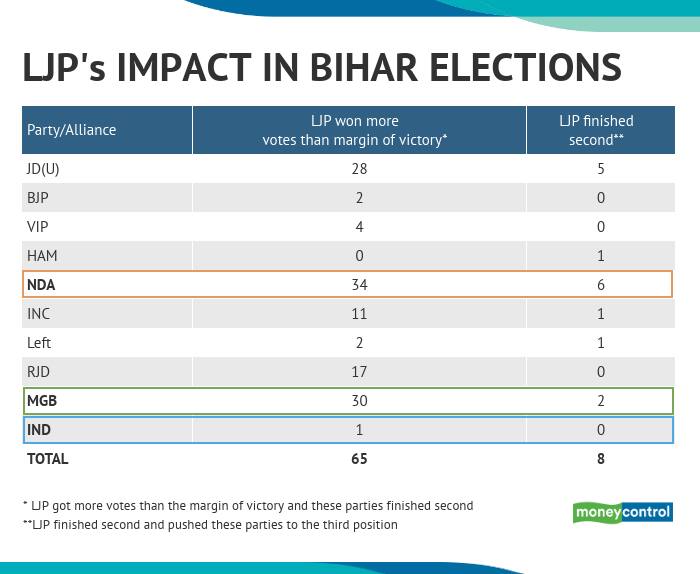The Lok Janshakti Party (LJP) could win only one seat in Bihar assembly elections. The party led by Chirag Paswan recorded a vote share of 5.66 percent.
The party contested in 137 of the 243 total seats, putting up candidates primarily against Chief Minister Nitish Kumar’s Janata Dal (United), former Chief Minister Jitan Ram Manjhi’s Hindustani Awam Morcha (HAM), Mukesh Sahani’s Vikassheel Insaan Party (VIP), and even on five seats against the Bharatiya Janata Party (BJP), after seat sharing talks with the National Democratic Alliance (NDA) failed. For Paswan and the LJP it was a question of survival.
After the results, Paswan exuded confidence that the party has strengthened during these elections contesting on a standalone basis. In an interview he said that his party’s main target was the JD(U), and it had succeeded in its endeavour.
He has refrained from attacking Prime Minister Narendra Modi and the BJP, even calling himself Modi’s Hanuman, in the hope of getting his father’s position back in the Union Cabinet. However, Paswan now shares an acrimonious relationship with state BJP leaders who have declared his career as over.
The LJP and the JDU were engaged in a verbal duel for many months before the elections with Paswan attacking Kumar on many counts. During the campaign, he even threatened to put Kumar in jail alleging corruption.
Chirag Paswan’s father Ram Vilas Paswan was fondly called ‘mausam vaigyanik’ for his ability to predict which way the wind was blowing in elections. He was a Cabinet minister in all governments since 1996, except in AB Vajpayee’s (1998-1999) and Manmohan Singh’s (2009-14).
Ram Vilas Paswan formed the LJP in 2000 after he split from the JD(U). In its first state elections in Bihar in 2005, the party won 29 seats with a vote share of 12.6 percent, leading to a hung assembly. The LJP didn’t back Rashtriya Janata Dal’s Rabri Devi as Chief Minister despite pressure from Congress’ Sonia Gandhi. This led to President’s Rule.
Six months later, the NDA won the re-elections and Kumar ended the 15-year rule of the RJD. The LJP could win only 10 seats in that election but its vote bank of Dalits was intact at 11.1 percent.
Kumar in 2009 carved out the Mahadalit category from the Schedule Caste population of 16 percent in a new social engineering experiment. This weakened the LJP, and it suffered successive losses in the 2009 general elections and the 2010 assembly elections.
Ram Vilas Paswan joined the NDA just before the 2014 general elections anticipating a Modi wave and enjoyed power in the Centre till his untimely death recently.
Rumour is that the BJP propped up Chirag Paswan to weaken the JD(U) and its claim on the Chief Minister’s chair. The LJP gave tickets to many rebel BJP and JD(U) candidates giving credence to such rumours. In the end, the JD(U) could win only 43 of the 115 seats it contested, with the LJP denting its prospects in 33 seats.

However, to conclude that the LJP only damaged the JD(U) would be wrong. Its candidates recorded more votes than victory margin in 73 seats. In 40 seats the LJP dented the NDA, but in another 32 seats it also played a key role in denying the Maha Gathbandhan (MGB) candidates victory. The above table highlights the destructive impact of the LJP on this election.
In effect, Chirag Paswan managed to send a clear message, and prove a point to both Kumar as well as RJD’s Tejashwi Yadav. The LJP has weakened Kumar’s moral claim on the top post putting him at the mercy of the BJP. To Yadav his message is that the RJD cannot win without his support, just like his father Ram Vilas Paswan made it clear to Lalu Prasad.
To the BJP he has proved that the LJP continues to hold sway over its core Pasi vote bank. The NDA needs the LJP to win a comfortable majority in Bihar. The LJP’s vote bank is freely transferable with a demonstrated track record. With the LJP in alliance, the NDA could have swept the state instead of a nail-biting finish.
In Phase 1 of the polls, where there are a good proportion of Dalits, the NDA trailed in 25 seats as the LJP cut the JD(U)’s votes. The LJP served three key roles in this election: One, to check in JD(U) (in 33 seats); two, to pull down the MGB by splitting votes (in 32 seats), and; three, to deny the BJP the status of the single-largest party.
On more than half the seats contested, the LJP played an influencing role in denying either the NDA or the MGB victory, and lived up to its reputation of a vote cutter. Chirag Paswan almost succeeded in creating a hung assembly (like his father did in 2005) and emerge as kingmaker.
With Kumar probably in his last election, Chirag Paswan has the potential to emerge as a change-maker along with Tejashwi Yadav in Bihar, and play a long political innings.




